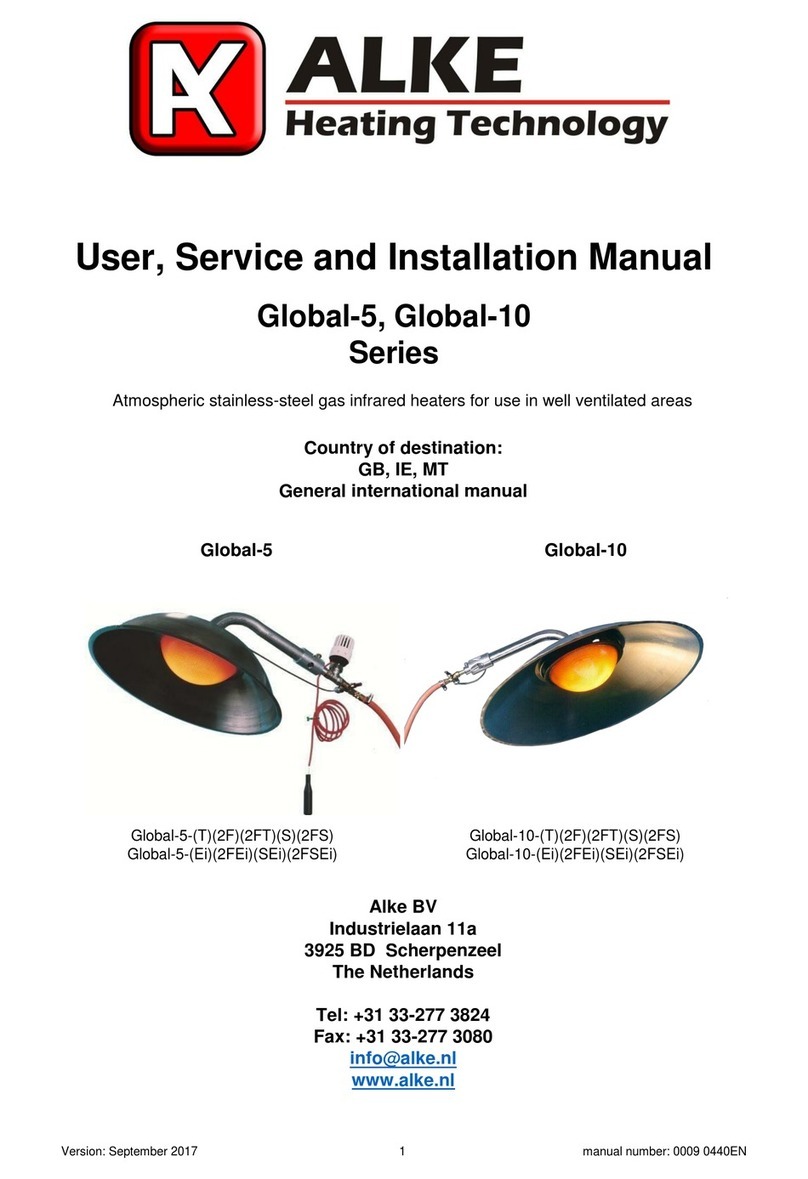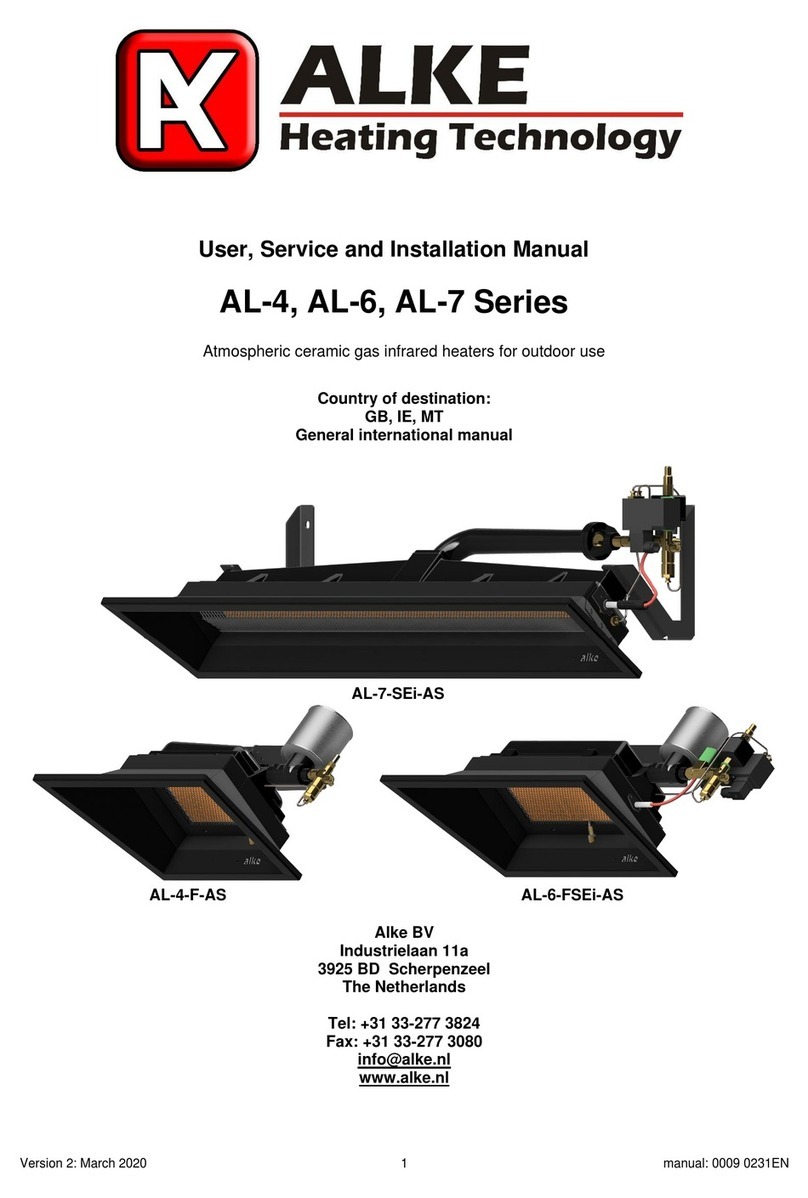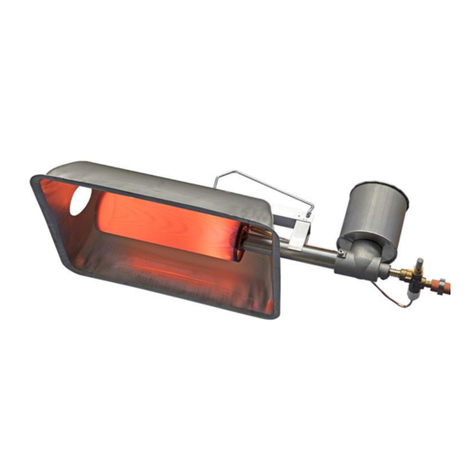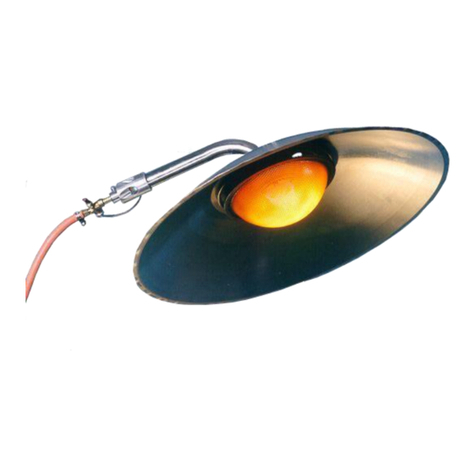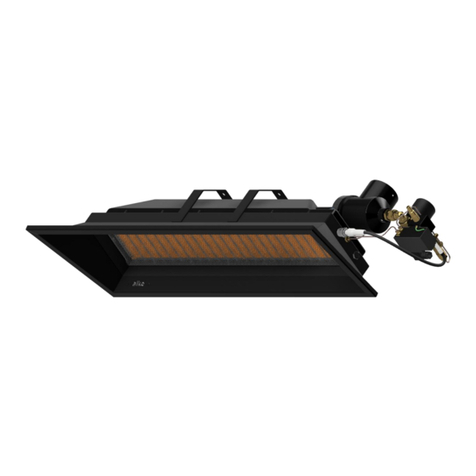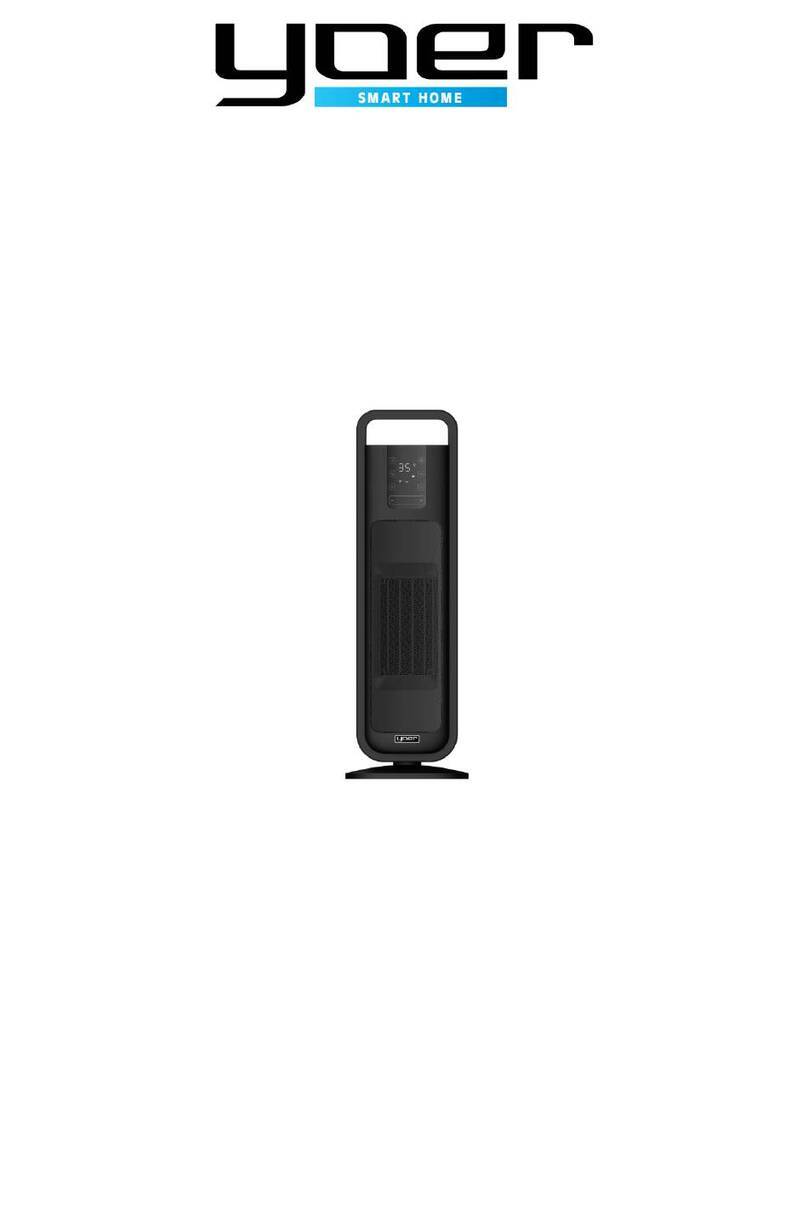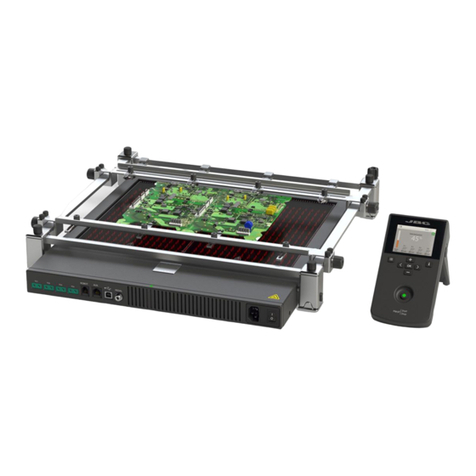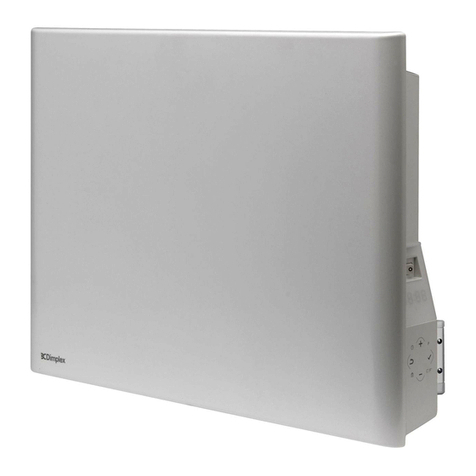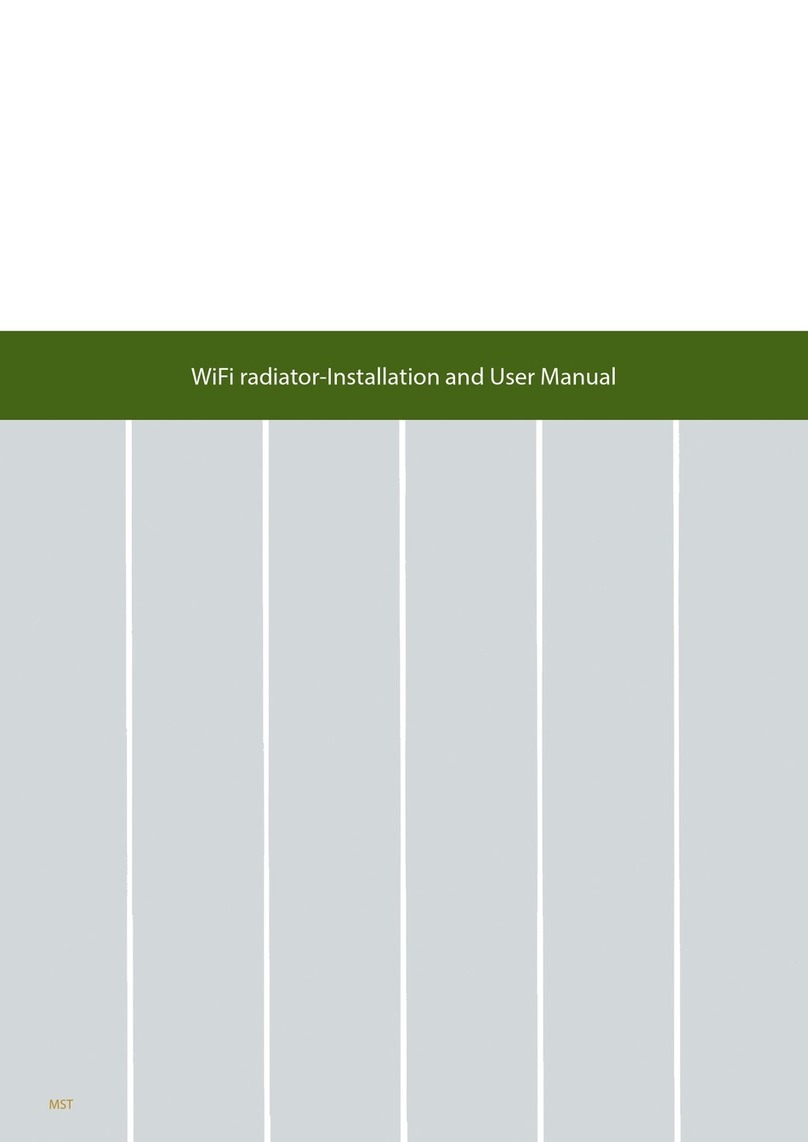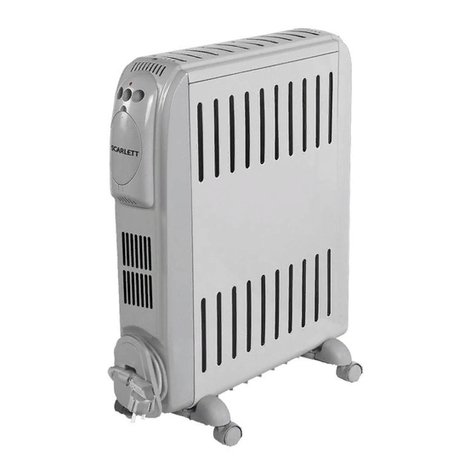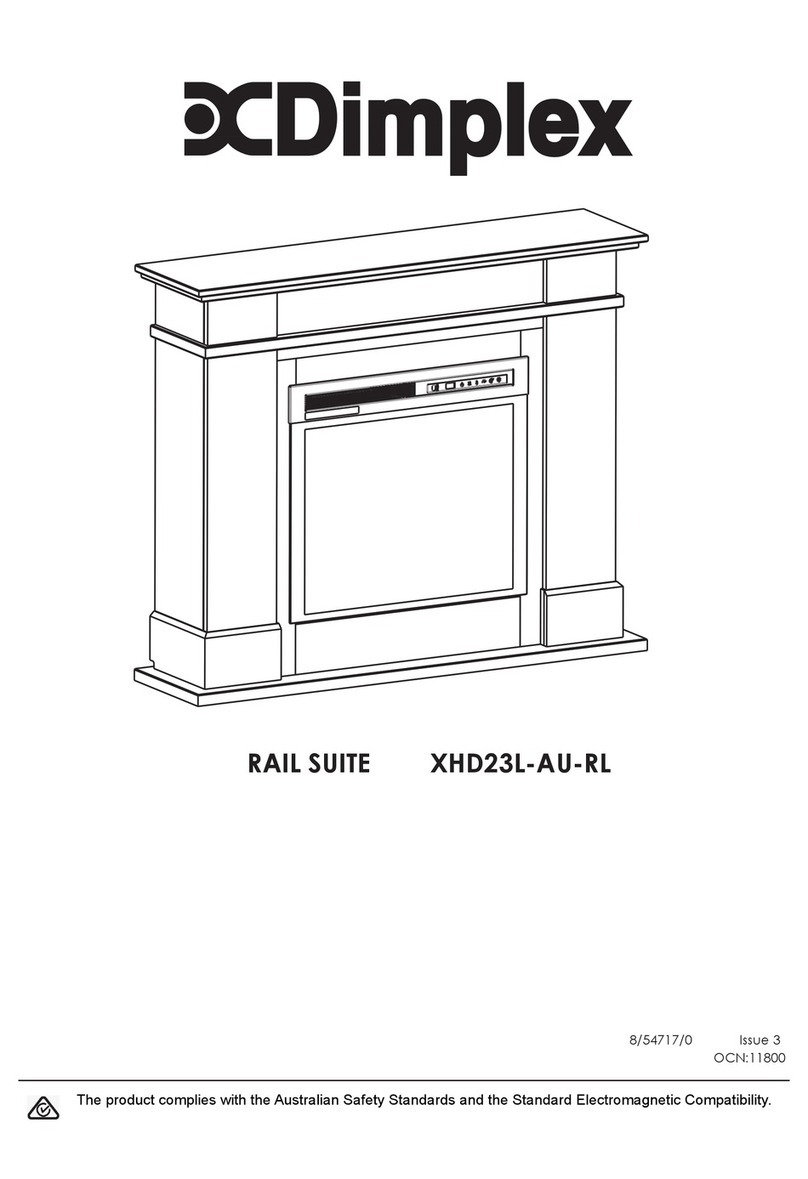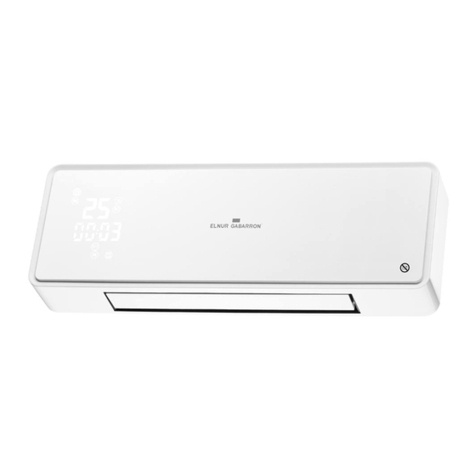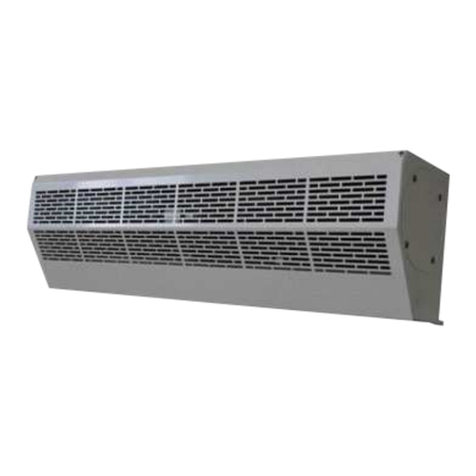Alke 41 Series Operating manual

Version: jan 2011 1Manual number: 0009 0520EN
User and Installation Manual
Alke 21, 41, 61, 81, 3000
(Versions: -SKTE, -SKTETH, -SKTETHi)
21, 41
61, 81, 3000
Manufacturer:
Alke BV
Industrielaan 11a
3925 BD Scherpenzeel
POBox 52
3925 ZH Scherpenzeel
The Netherlands
Tel: +31 33 277 3824
Fax: +31 33 277 3080
Warning
All purchasers, installers and users shall read the instructions and data plate carefully before installation,
operation, use or servicing of the gas heater. Not following these instructions can result in death, serious injury,
fire or property damage. In that case all responsibility of any accident whatsoever in connection with the
purchase, installation, operation, using and servicing of the gas heater and accessories will be rejected. Keep
this manual for future reference.
Safety advice
The gas heater and accessories shall be installed and tested on site by a qualified, competent and
approved gas installer, according this manual and according all applicable local and national regulations.
The gas heater is designed for the brooding of selected livestock, like: chickens, piglets, game birds, ducks,
etc. within livestock rearing housing, or for local heating projects outside, or in workshops or other industrial
environment. It is not designed for any other heating applications. Do not use it inside habitable parts of
buildings and houses or for domestic use.
All air inlets in the livestock house shall be inspected and checked regularly to be clear of dust, dirt and any
foreign material to allow the free flow of fresh air into the building.
For safe operation a fresh air supply to the heater of at least 20 m³/h per 1 kW installed heat input is needed.
Note that in most situations animals need much more fresh air. A well ventilated area is very important for
safe operation of a gas heater. Follow in non-agricultural situations the requirements of EN13410.
Use only gas cylinders with a gas isolation valve or gas lines with a main gas valve at the beginning. In
case more than one heater is connected to a gas system, place also a gas tap directly before the heaters.
Close these taps when the heaters are not in use.
Do not use the heater in areas where gasoline or flammable liquids or gases may be present. Also keep a
safe distance to other easy inflammable materials like curtains, etc.
Do not touch, move, handle or service the gas heater while it is burning.

Version: jan 2011 2Manual number: 0009 0520EN
Before doing any maintenance, installation or service, first close the gas supply and wait till the gas heater
has cooled down.
Propane gas and natural gas are very flammable and are scented with a strong smell. If any gas smell is
noticed, immediately turn off the gas supply. Do not ignite or operate any gas heater in the area until the
leak has been found and repaired. Never strike any match or lighter or create any spark when you smell
gas. Immediately ventilate the building, open all doors, windows and air inlets. Call for your local qualified
gas installer to solve the leakage.
Check regularly with soapy water all gas carrying parts and connections on gas leaks.
Do not use any portion of the gas heater manifold, gas valve pressure regulator or gas line as a structural
support for the heater. Always use a galvanized support chain, and never rope or plastic materials.
Never operate the gas heater with a broken ceramic stone. Repair or replace it directly.
If a heater is not safe to use anymore, remove it so that nobody accidentally operates the heater. Store the
heater in a safe place, mark it that it cannot be used, and contact a service agent or gas installer to solve
the problem.
Thermostat
The thermostat knob TH is always delivered separated from the thermostat valve.
1) Remove the protection cover (if any) from the thermostat valve.
2) Turn the knob on maximum temperature and push the knob on the valve.
3) Fix the knob by turning the large metal screw ring till it stops (at least 2 turns, hand tight).
For thermostats TH with a remote sensor only: bend the sensor line carefully (no sharp bends) to the thermostat
valve and secure the sensor line with a ty-rap around the red protection lining and the thermocouple safety
device (see picture). Note that the tubing is hollow, a sharp bend will close the tubing and makes the sensor
worthless. The chance of breaking the line at the entrance of the thermostat knob is largely limited now.
Installation conditions
The gas heater has been produced and assembled in The Netherlands (Europe), using only high quality
materials. Your gas heater will provide a high degree of operational safety and a long working life. All gas heaters
are tested before leaving the factory. Therefore parts can be discoloured a bit due to the heat during testing.
The gas heater is ready to operate and needs no further adjustment or assembly anymore. Please note that
safe and proper working cannot be guaranteed anymore when alterations are made to the gas heater or non-
original components are used. This is dangerous and forbidden to do.
The heater is intended for use in well ventilated areas only. Do not install the heater in situations that are not
well ventilated. Check also your local regulations for the ventilation and room size requirements. The amount of
heaters per building depends on the type of building, the animals, the insulation, the climate and local wind
conditions. Check with your installer or distributor for a calculation to determine the amount of heaters needed.
Check the data plate on the gas heater and check if the gas supply and gas pressure regulator are in
correspondence with it. Never use it on other gases or pressures. Always connect the gas heater to the gas
supply using an approved gas hose. Never use water hoses! Always secure the gas hose with hose clips. Make
sure that the gas hose, gas lines, electric lines, lamps, etc. are not heated by the gas heater. If more gas heaters
are connected to one gas pipe system, make sure that the pipe is large enough to maintain the correct gas
pressure for all heaters in operation. Consult a qualified gas installer to calculate the pipe dimensions needed.
Never use LPG appliances below ground level.

Version: jan 2011 3Manual number: 0009 0520EN
Keep always a safe distance around the gas heater to other materials and walls. See the table below for the
minimum safety distances. The operational distances are guidelines to start with. Adjust later on to the correct
height based on your personal preference and experience. For non-agricultural installations keep a distance of
at least 2,0 meters from floor to the heater.
Operational Distances
21
41
61
81/3000
To the animals
50 –80 cm
70 –100 cm
110 –150 cm
120 –160 cm
Minimum Safety Distances to
combustible materials
21
41
61
81/3000
To the ceiling
>50 cm
>50 cm
>50 cm
>50 cm
To the sides
>50 cm
>50 cm
>60 cm
>70 cm
Under the heater
>50 cm
>60 cm
>80 cm
>90 cm
Heater installation The heater is intended for suspension only. Use only galvanized chain.
Do not use the gas line, gas hose or electric lines for suspension
purposes. Never use rope or plastic mounting materials. Make sure that
the heater is mounted under an angle of 15 degrees with the gas safety
device at the lower end.
Make sure that the location is free of air draft. In case there is air draft,
turn the heater in such a way that its radiation surface is not influenced
by the draft.
The gas hose shall be hanging free with a distance of minimal 1 meter
from the ground, so that animals will not damage the hose. Connect
the hose always via an individual gas tap to the central gas supply.
Make sure that the hose is not under stress or twisted.
A guideline for placement of the sensor of the temperature regulation is 60 cm above the ground and minimal
40 cm away from a heater. Use sensors with a black surface in case the regulation is based on measuring the
infra red temperature.
Gas cylinders
Keep full or empty gas cylinders away from any heat source and keep them standing upright. Never leave
cylinders lying flat on the ground, or in any hole, or a place below ground level (like cellars or basements). Store
the gas cylinders always in accordance with the applicable local requirements. At the temperature of 10 degrees
C approx. 9 till 14 kW per hour can be supplied from 1 gas cylinder of 45 kg or 5 kW per hour from a gas cylinder
of 10 kg or more.
Changing gas cylinders
In case gas cylinders are used, changing or connecting gas cylinders must be done preferably outside, or in a
well ventilated area, in a flame-free environment and away from other people.
Check if there are no other operating heaters, other gas heaters, burning candles or people smoking
cigarettes in the area.
Be sure that the valve on the gas cylinder is closed and the burner of the heater is extinguished.
Unscrew the nut by which the gas regulator is connected to the gas cylinder valve. (Note that most
connections are with left-handed threads. They open in clockwise direction).
Before connecting the (new) gas cylinder, first check if the rubber seals on the cylinder valve or on the
regulator connecting nut are fitted properly and able to fulfil its function and are not damaged or worn. If the
last case is true, do not use it and replace the seals first.
After connecting the regulator firmly, open the cylinder valve and check with soapy water if the connection
is leak tight. If bubbles appear, the connection leaks. Do not use the heater unless the system is sound.
Gas line supply
In case a main gas line supplies the gas to the heaters, make sure that an authorised company in your country,
in accordance with the local rules and requirements, install the system. To avoid problems, use galvanised or
copper tubing for the gas line. First make a calculation to determine the capacity of the whole system and the
diameters of the piping in each section. Use the common available calculation methods as written in most gas
installation standards. Contact an installer or the distributor in case this calculation method is not available in
your area. For data needed to calculate the dimensions of the gas line, see the technical table on the last page.

Version: jan 2011 4Manual number: 0009 0520EN
The most common way to install a gas line is in the centre of the barn (at least 2 meter high) with every 3 to 5
meter a “T” or “cross” connection for gas supply to the heaters. Always mount a (easy reachable) gas tap at the
beginning of the gas hose to the heaters. This gas tap is needed to close the gas supply to the burners to
extinguish the flames. In addition, it makes it possible to remove the heaters after use or to service the heaters
safely. The gas inlet at the heater side is normally an 8 mm hose nipple (optional a smooth hose nipple or a
G1/8” right handed thread. Other connections are possible after consultation). Always use approved gas sealant
to close the gas connections.
Soundness check
Before using a new built gas system, first make sure that the installer made a careful and extensive check for
gas leakage. After executing a pressure drop test to determine if there are not large leaks, check every
connection with soapy water or gas detection liquid with all gas valves in open position and with maximum gas
pressure. Pay special attention to the hose connections. Maintain maximum air ventilation during the test.
Repeat this check at least every year. This soundness check shall be done by a competent installer only.
Gas leakage
When a gas leak is detected, immediately close the gas supply and disconnect electricity. Keep flames away.
Do not use the heater anymore. Contact an authorised gas technician, gas installer or gas service agent to
determine if the gas leakage can be repaired. Never try to do gas repairs by yourself. Do not use the heater
anymore until the problem is solved.
Burner operation
New heaters need a cleaning period before they are ready for operation. Turn the ventilation to maximum
position or place the heaters outside in the open air. Fire the heaters for at least two hours on full capacity to
burn-off oily and greasy remnants of the production. Make sure that after two hours all smoke and smell is
disappeared. The smoke and smell can be unhealthy, so keep animals and human beings away till the heaters
and the environment air is clean.
The gas heater burns properly when the colour of the ceramic stone and burner gauze is orange/red. In case
the flame burns outside the burner gauze, check and clean the heater first and clean the filter. Also bad quality
gas or wrong gas pressure can cause this. Consult a gas installer in this case. The installation of the heater in
a draughty area may result in a loss of efficiency. If possible install in a draft free area or turn the face of the
heater away from the draft.
Ignition procedure (always ignite on maximum gas pressure)
Open the gas valve on the gas cylinder / gas tank / gas pipe and turn the gas pressure regulator at
maximum capacity. Turn the thermostat on maximum temperature.
Check all gas connections, hoses and gas regulators for leaks with soapy water.
Ignite a safety match or BBQ gas lighter and keep the flame at the burner gauze (2).
Press the button of the safety device (15). The gas heater shall ignite now within a few seconds.
Continue to press the button of the safety device for approx 25 seconds and then release it.
In case you have an appliance with adjustable heat input, adjust the pressure regulator to the setting
required or set the thermostat on the requested temperature setting to obtain the heat output you need.
If the gas heater goes out, wait for about 3 minutes and repeat the above ignition procedure.
Shut off procedure
Turn down the gas pressure regulator and close the gas valve on the gas cylinder / gas tank / gas pipe. The
gas heater will extinguish now and the safety device will close after 60 seconds. Wait 3 minutes before opening
the gas valve and re-ignition of the gas heater.
Game rearing
Ceramic heaters are used a lot for game rearing. Especially for game rearing, due to the small cages and active
birds, pay a lot of attention to cleaning and ventilation. While the cages are small, the effect of lack of ventilation
and not cleaning will be directly cause the death of birds in a short time. While normally one heater is used for
one cage, we advice to add an independent temperature alarm system for those situations where a temperature
drop due to a (gas)failure will result in bird loss.

Version: jan 2011 5Manual number: 0009 0520EN
Maintenance
The frequency of maintenance is strongly depending on the quality of the combustion air and the intensity of
use. When used in poultry houses, maintenance is advised every 6 weeks or by changing the animals. By use
in clean environment conditions, the maintenance period can be extended, but not longer than 6 months. In
case heaters are not used for a long period, always do maintenance first before using them again.
In case the heaters need to be stored for a long time, make sure that no dust, spiders, etc. can enter the heater.
Use the carton packaging box to store the heater, or a plastic bag if the box is not available anymore, and close
this carefully.
Parts that are broken, or are not functioning well, must be replaced directly by identical ones of same brand and
type. Consult the dealer or manufacturer in case of doubt.
Daily maintenance
In dusty or dirty environments check and clean a heater every day with a soft brush. Specially pay attention that
the venturi (8) (or venturi tube if no venturi is needed) remains clean. In case a heater is not cleaned internally
the heat efficiency will drop and the lifetime of the burner will become shorter. Also there is a possibility that
carbon monoxide (poisonous) will be produced and soot deposit will occur. To keep the heater free of dust is
important. Check also the condition of the gas hose daily for damage, cracks, ageing, etc.
Dust filter Dust filters must be check every day and cleaned in case needed.
Remove a filter before cleaning. Dry dust can be removed by tapping the
filter softly against a solid surface, like the sole of a shoe. The dust will
fall off easy now. In case the filter is still not clean, brush the surface
gently with a brush or clean it with compressed air from inside to the
outside. In case the dust is greasy, clean the filter in warm water with a
bit detergent. Make sure that filters are dry before placing them back.
Even with the use of a filter still check the heater regularly inside while
very fine dust still will pass the filter and pollute the heater internally.
Sequence of periodic maintenance
Warning: Wear safety goggles during cleaning with compressed air.
Warning: Never use water to clean the heater or ceramic stones internally.
First clean the heater and filter (11) as described by daily maintenance.
Clean the reflector and other external parts with water, a mild detergent and a cloth or soft brush.
Carefully inspect the ceramic stones on damage, cracks and holes. Replace when needed.
To clean the burner (5), burner gauze (2) and ceramic stone (22) use an air hose (pressure max 2 bar/30
psi) and blow inside the venturi (8) and on the ceramic stone (22). Do this for 60 seconds and repeat 2-3
times. Never use water to clean your heater or any steel brush
Check the injector for obstructions. Remove obstructions by brushing them away and by using a pin or drill
to clean the injector hole. Make sure that the injector hole does not become wider by using a pin or drill that
is larger than the size stamped on the side of the injector.
Clean the inside of the gas safety device and injector with compressed air. Make sure that the pressure of
the compressed air is not more than the 1,5x the gas pressure mentioned on the data plate (20 till 1400
mbar). Otherwise the rubber seals inside the safety device will become damaged.
Check the condition of the thermocouple sensor. Replace in case the tip is burnt-in already, or the copper
tube is kinked, to avoid unnecessary shut down later on.
Check all gas carrying parts and connections for gas tightness with leak detection liquid or soapy water
according the procedure in the standards applicable in the local installation situation. Never use a flame for
soundness checks!
In case a gas hose and/or gas regulator is used, check these carefully for cracks, wear and other signs of
damage or alteration. Replace it when the maximum lifetime printed on the hose and/or gas regulator (or
the maximum allowed by local requirements) has been passed.
Commission the heater after maintenance and check it carefully during first ignition, firing and extinguishing.

Version: jan 2011 6Manual number: 0009 0520EN
Fault finding table
Trouble
Action
Burner does not light.
Check if the gas valve of the gas cylinder or gas line is open
Check if the gas cylinder is empty
Note that first ignition will take 60 or more seconds before gas is available
Check if the gas injector (12) is blocked
Check if the gas pressure / gas quality is identical to the data plate information
Burner extinguishes
after lighting
Keep button safety device (15) pressed for a longer period (up to 25 seconds)
Check if the thermocouple (19) is connected properly to the gas safety device
Check if the thermocouple tip (19) senses the heat of the burner
Thermocouple (19) or magnetic coil of the safety device (15) is broken
Gas pressure lower than minimum requested
Gas heater not suspended at 15 degrees angle
Flames leave the
- confines of the burner,
- or are sooting,
- or a blue cloud is
under the reflector
Gas pressure is too high. Check the gas pressure with the data plate
Check if the gas pressure regulator is broken
Wrong gas is used. Check data plate for the correct gas supply
Venturi/air inlet is blocked/dirty
Check the size of the venture (8) and injector (12) with the table
Air filter (11) is dirty or not enough fresh air available
Check position axle bore (14) and move to correct position
Gas heater not suspended at 15 degrees angle
The burner is only partly
glowing
Wrong gas or pressure is used. Check data plate with the gas supply
Check if the injector (12) or venturi (8) are blocked or dirty
Check the injector (12) and venture size (8) with the table
Check the setting of the thermostat (24)
Check if pipe sizes or gas hoses have sufficient capacity
Burner makes a lot of
roaring noise (back
flash)
Check if ceramic stone (22) is broken
Check gas quality, and if gas pressure is to high, with data plate information
Check position axle bore (14)
Check size venturi (8) (Note that some types no separate venturi is needed:
size is 15mm)
The burner do not work
at minimum position
Gas pressure is not correct. Check the gas pressure with the data plate
Wrong gas is used. Check data plate for the correct gas supply
Check the size of the venture (8) and injector (12) with the table
Injector (12) (partly) blocked
Check if the thermocouple tip (19) senses the heat
Sensor or wire thermostat TH (24) is broken
Thermostat TH valve adjusting mechanism (24) is blocked
By-pass hole thermostat (24) is blocked
Heater will not attain the
desired temperature
There is insufficient heat in the building for heat loss (i.e., not enough heaters).
The thermostat TH sensing bulb (24) is incorrectly placed
The thermostat TH (24) is out of calibration or broken
Injector (12) partly blocked
Declaration of conformity
We, Alke B.V., located in Scherpenzeel, The Netherlands, hereby declare that the 21, 41, 61 and 81 series,
marked on their data plates with CE and with the CE approval/production supervision number 0063 of Kiwa
Gastec are in compliance with the Directive on appliances burning gaseous fuels (2009/142/EC) (ex
90/396/EEC)
Scherpenzeel, 01-01-2011
Adri van Alphen Derk Jan Keurhorst
Managing Director Managing Director

Version: jan 2011 7Manual number: 0009 0520EN
Parts list
The parts list below is a combination list of all 21, 41, 61 and 81 models. Most parts of these models are identical.
Consult the data plate to determine the model you have before using this list.
No
Amount
21
Part Number
41
Part number
61
Part Number
81/3000
Part Number
Description
1
1
02300000
02301000
02304000
Reflector (Enamel Black)
2
1
02400000
02401000
02403000
Burner gauze
3
4
07147000
Screw + washer M4x33 galv.
4
4
07401000
Nut M4 galv.
5
1
**)
**)
**)
Burner house Alu or Enamel Black
6
1
03901000
Suspension hook “Uni”
7
1
07010000
Star lock washer 6mm
8
1
01316xxx **)
Venturi 15x30 (if applicable)
9
1
01799000
Connection piece type “81” (small)
10
4
07135000
Screw M5x10 SS
11
1
02530000
Dust filter 35x80x90 SS (if applicable)
12
1
0120xxxx **)
Injector M8x0,75
13
1
01301000
Injector holder M8
14
1
07004000
Axle bore Ø 9mm
15
1
00101000
Safety Device w/o hose pillar*)
15a
1
00106000
Safety Device + hose pillar*)
16
1
X
X
02475000
Gas distribution plate
17
1
01327000
Hose pillar 1/8” female x 8mm (see 15)
18
1
07000000
Dust cap 9,5x16
19
1
00200000
Thermocouple M8x320mm
20
1
03905000
Thermocouple bracket 8mm
21
2
07013000
Parker screw 3.5x6.5 galv.
22
1
02621000
02622000
02623000
02624000
Ceramic stone HD (>50 mbar)
22a
1
02601000
02602000
02603000
02604000
Ceramic stone LD (<50 mbar)
22b
1
X
X
X
02604010
Ceramic stone effect (<50 mbar)
02650010
Ceramic glue
23
1
01429000
Reducing nipple 1/8” x 3/8” (TH)(THi)
24
1
0092xxxx **)
Thermostat assembly (TH)(THi)
25
1
01405000
Reducing ring 3/8” x 1/8” (TH)(THi)
*) Hose pillar can be an integrated part of the safety device (see 15a)
**) Contact the dealer/manufacturer for the correct part number due to many different models

Version: jan 2011 8Manual number: 0009 0520EN
Technical table
Category
Gas
Supply
pressure
Supply
pressure **
Maximum
Heat Input
Minimum
Heat Input
Gas consumption
Main Injector
By-pass
hole
**
Venturi
Ring
Injector
Holder
Weight
(TE)/(TH)
Remarks
(-)
(-)
(mbar)
(mbar)
(kW Hs)
(kW Hs)
(g/h or m3/h)
(mm)
(mm)
(mm)
(-)
(kg)
(-)
21 series
I2L
G25
25
x
1,0
x
0,11 m3/h
0,76
x
15
0
2,6/2,9
I2H, I2E
G20
20
x
1,1
x
0,10 m3/h
0,76
x
15
2
2,6/2,9
I2E+
G20/G25
20/25
x
x
x
x
x
x
x
x
x
I2ELL (LL)
G25
50
x
1,2
x
0,13 m3/h
0,71
x
9
2
2,6/2,9
I2ELL (E)
G20
50
x
1,2
x
0,12 m3/h
0,64
x
9
3
2,6/2,9
I3P
G31
28
x
0,72
x
52 gr/h
0,48
x
15
4
2,6/2,9
-
I3P
G31
50
x
1,0
x
72 gr/h
0,47
x
15
2
2,6/2,9
I3P
G31
150
50
0,75
0,45
54 gr/h
0,33
x
9
4
2,6/2,9
-
I3P
G31
200
50
1,0
0,5
72 gr/h
0,33
x
9
5
2,6/2,9
-
I3P
G31
1400
350
1,0
0,5
72 gr/h
0,22
x
6,5
2
2,6/2,9
41 series
I2L
G25
25
x
1,9
x
0,21 m3/h
1,05
x
15
2
3,65
I2H, I2E
G20
20
x
1,9
x
0,19 m3/h
0,95
x
15
2
3,65
I2E+
G20/G25
20/25
x
x
x
x
x
x
x
x
x
I2ELL (LL)
G25
50
25
1,8
1,3
0,20 m3/h
0,85
x
9
2
3,65
I2ELL (E)
G20
50
25
1,8
1,3
0,17 m3/h
0,77
x
11
1
3,65
I3P
G31
28
x
1,5
x
107 gr/h
0,64
x
15
4
3,65
-
I3P
G31
50
x
1,55
x
110 gr/h
0,59
x
11
5
3,65
-
I3P
G31
150
50
1,65
1,0
118 gr/h
0,46
x
10
6
3,65
-
I3P
G31
200
50
1,75
0,85
125 gr/h
0,44
x
9
4
3,65
-
I3P
G31
1400
500
1,7
1,0
120 gr/h
0,27
0,22
6,5
4
3,65
61 series
I2L
G25
25
x
2,4
x
0,27 m3/h
1,20
x
15
2
4,9
I2H, I2E
G20
20
x
x
x
x
x
x
x
x
x
I2E+
G20/G25
20/25
x
x
x
x
x
x
x
x
x
I2ELL (LL)
G25
50
25
2,3
1,6
0,25m3/h
0,85
x
11
0
4,9
I2ELL (E)
G20
50
25
2,3
1,6
0,22 m3/h
0,94
x
11
3
4,9
I3P
G31
30
x
x
x
x
x
x
x
x
x
I3P
G31
50
x
2,1
x
150 gr/h
0,74
x
15
2
4,9
I3P
G31
150
50
2,6
1,5
185 gr/h
0,57
x
11
6
4,9
-
I3P
G31
200
50
2,3
1,2
165 gr/h
0,54
x
11
2
4,9
I3P
G31
1400
350
2,5
1,3
179 gr/h
0,35
x
9
2
4,9
81 series
I2L
G25
25
x
3,5
x
0,39 m3/h
1,4
x
15
5
4,9
-
I2H, I2E
G20
20
x
3,1
x
0,33 m3/h
1,3
x
18
5
4,9
I2E+
G20/G25
20/25
x
x
x
x
x
x
x
x
4,9
I2ELL (LL)
G25
50
25
3,4
2,3
0,38 m3/h
1,15
x
15
1
4,9
-
I2ELL (E)
G20
50
25
3,5
2,4
0,33 m3/h
1,05
x
15
5
4,9
-
I3P
G31
28
x
2,65
x
190 gr/h
0,85
x
18
6
4,9
-
I3P
G31
30
x
2,75
x
195 gr/h
0,85
x
18
6
4,9
-
I3P
G31
50
25
3,0
1,9
215 gr/h
0,80
0,85
17
4
4,9
I3P
G31
150
50
3,0
1,75
215 gr/h
0,61
0,47
11
6
4,9
-
I3P
G31
200
50
3,0
1,55
215 gr/h
0,58
0,50
11
2
4,9
I3P
G31
1400
300
3,4
1,7
245 gr/h
0,38
0,27
9
2
4,9
-
** In case the heater is equipped with a bypass hole (TH, THi version) the heater shall be operated on maximum supply pressure only. See also the pressure information on the data plate.
Other manuals for 41 Series
1
This manual suits for next models
4
Other Alke Heater manuals
